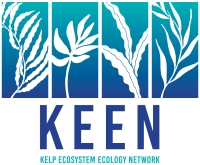Biology Department, University of Massachusetts Boston
Type of resources
Topics
Keywords
Contact for the resource
Provided by
Years
-

Observational data for the Kelp Ecosystem Ecology Network. These data come from transects of rocky reefs taken around the world using the KEEN observational data protocol (see http://kelpecosystems.org for full description of methods and handbook). See “How” for methods. Briefly, the observational data consists of the following components, all included here: site information, fish observations, quadrat sampling, band transect sampling, percent cover from uniform point counts, and kelp morphometrics. Data Files Data files included and what they contain are as follows: keen_sites.csv - Physical and locational data for all KEEN sites and transect. keen_cover.csv - Percent cover of sessile algae and invertebrates. keen_fish.csv - Counts of fish by size class along a transect. keen_quads.csv - Counts of common algae, sessile invertebrates, and demersal fish that can be individuated. keen_swath.csv - Counts of rarer algae, sessile invertebrates, and demersal fish that can be individuated. Data Use To use the observational data here for published work we ask that 1) You contact the network coordinator, jarrett.byrnes@umb.edu, and notify them of your intention so that we can coordinate among any ongoing projects using the same data, 2) if the data has not been used in a publication in the literature before, we request that you reach out to the PIs responsible for the data you will be using and engage in a conversation about co-authorship, 3) if it has been used previously, merely cite the datasets associated with each PI that you use. The references are listed below. For access to the entire data cleaning and processing pipeline, see https://github.com/kelpecosystems/observational_data. For access to scans of the original data sheets, contact jarrett.byrnes@umb.edu. ------------------------------------------------------ For general methods: Byrnes, Jarrett E.K., Haupt, Alison J., Reed, Daniel C., Wernberg, Thomas., Pérez-Matus, Alejandro., Shears, Nick T., Konar, Brenda, Gagnon, Pat, and Vergés, Adriana. 2014. Kelp Ecosystem Ecology Network Monitoring Handbook. Kelp Ecosystem Ecology Network. For specific data sets, use the following, but also include date accessed from TemperateReefBase in order to track which version of the data you are using. Byrnes, Jarrett E.K., Haupt, Alison J., Lyman, Ted. 2014. Kelp forest communities at Appledore Island, the Boston Harbor Islands, and Salem Sound. Kelp Ecosystem Ecology Network. Dijkstra, Jennifer A., Mello, Kristen. 2015. Kelp forest communities at York, Maine. Kelp Ecosystem Ecology Network. Grabwoski, Jonathan and MacMahan, Marissa. 2015. Kelp forest communities in Nahant, Massachusetts, and Pemaquid, Maine. Kelp Ecosystem Ecology Network. Humphries Austin T., Paight C, Ben-Horin Tal, Green Lindsay, Thornber, Carol. 2016. Kelp forest communities in Narragansett Bay, Rhode Island. Kelp Ecosystem Ecology Network. Rasher, Douglass and Price, Nicole. 2017. Kelp forest communities of central and downeast Maine. Kelp Ecosystem Ecology Network. Peréz-Matus, Alejandro and Shaughnessy, Brianna. 2017. Kelp forest communities of central and northern Chile. Kelp Ecosystem Ecology Network.
-
This dataset comes from the Floating Forests project (http://floatingforests.org). Floating Forests is an online citizen science project attempting to map the cover of surface-canopy forming kelps, primarily the giant kelp Macrocystis pyrifera, using Landsat data. To acquire the data, citizen scientists were given tiles of images taken from the Landsat series of satellites (https://landsat.usgs.gov/) scenes that had been manipulated to make kelp more visible. Landsat has a roughly two week repeat time for the entire globe and a 30m resolution, although given variability in weather quarterly aggregation is recommended. Each image was scene at minimum four times. If no kelp was noted, then it was retired and scored as a zero. If kelp was noted in the first four classifications, then an individual image was shown to fifteen people total. The polygons of kelp beds presented here represent consensus classifications from the platform and are tagged with minimum number of users who classified pixels in the polygons as kelp. For example, at the five user threshold, each area represents pixels where at least five users - not neccesarily the same five users - said there was kelp present. This consensus classification has been shown to match very closely to expert classifications. For more information and links to outputs, see http://blog.floatingforests.org in addition to the main project site. Or go to the main project site, and start a conversation in the "talk" section of the site.
-

This global meta-analysis documents data from underwater visual surveys used to determine the effect of kelp bed disturbance and canopy density on the abundance and structure of fish communities. Spatial, temporal and ontogenetic variability of many key fish species was examined at various levels of kelp disturbance at sites spanning a global temperate distribution. Rocky reef habitats and fisheries management regimes of sites were also examined as covariates.
-

This global meta-analysis documents seasonal and interannual variability in the structure of reef-based kelp dominated communities. Temporal trends in kelp biomass, stipe density, percent cover, and rates of change of kelp density are measured across various ecoregions in global temperate zones.
 TemperateReefBase Geonetwork Catalogue
TemperateReefBase Geonetwork Catalogue